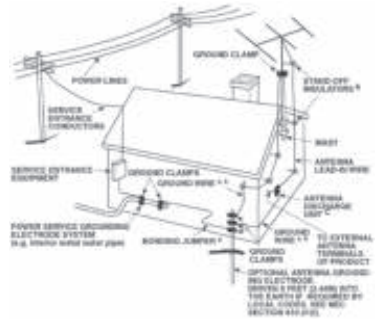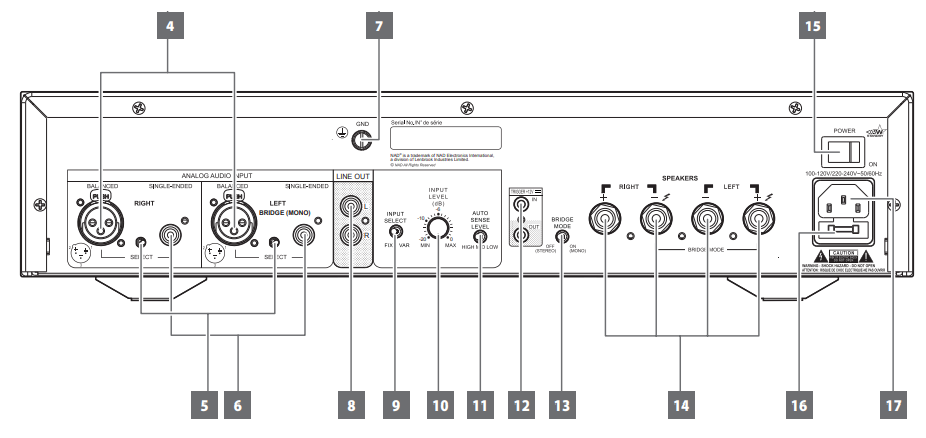
C 268Stereo Power Amplifier
Owner’s Manual
IMPORTANT SAFETY INSTRUCTIONS
SAVE THESE INSTRUCTIONS FOR LATER USE. FOLLOW ALL WARNINGS AND INSTRUCTIONS MARKED ON THE AUDIO EQUIPMENT.
- Read instructions – All the safety and operating instructions should be read before the product is operated.
- Retain instructions – The safety and operating instructions should be retained for future reference.
- Heed Warnings – All warnings on the product and in the operating instructions should be adhered to.
- Follow Instructions – All operating and use instructions should be followed.
- Cleaning – Unplug this product from the wall outlet before cleaning. Do not use liquid cleaners or aerosol cleaners. Use a damp cloth for cleaning.
- Attachments – Do not use attachments not recommended by the product manufacturer as they may cause hazards.
- Water and Moisture – Do not use this product near water for example, near a bathtub, washbowl, kitchen sink, or laundry tub; in a wet basement; or near a swimming pool; and the like.
- Accessories – Do not place this product on an unstable cart, stand, tripod, bracket, or table. The product may fall, causing serious injury to a child or adult, and serious damage to the product. Use only with a cart, stand, tripod, bracket, or table recommended by the manufacturer, or sold with the product. Any mounting of the product should follow the manufacturer’s instructions and should use a mounting accessory recommended by the manufacturer.
 A product and cart combination should be moved with care. Quick stops, excessive force, and uneven surfaces may cause the product and cart combination to overturn.
A product and cart combination should be moved with care. Quick stops, excessive force, and uneven surfaces may cause the product and cart combination to overturn.- Ventilation – Slots and openings in the cabinet are provided for ventilation and to ensure reliable operation of the product and to protect it from overheating, and these openings must not be blocked or covered. The openings should neverbe blocked by placing the product on a bed, sofa, rug, or another similar surface. This product should not be placed in a built-in installation such as a bookcase or rack unless proper ventilation is provided or the manufacturer’s instructions have been adhered to.
- Power Sources – This product should be operated only from the type of power source indicated on the marking label. If you are not sure of the type of power supply to your home, consult your product dealer or local power company. The primary method of isolating the amplifier from the mains supply is to disconnect the mains plug. Ensure that the mains plug remains accessible at all times. Unplug the AC power cord from the AC outlet if the unit will not be used for several months or more.
- Grounding or Polarization – This product may be equipped with a polarized alternating-current line plug (a plug having one blade wider than the other). This plug will fit into the power outlet only one way. This is a safety feature. If you are unable to insert the plug fully into the outlet, try reversing the plug. If the plug should still fails to fit, contact your electrician to replace your obsolete outlet. Do not defeat the safety purpose of the polarized plug.
- Power Cord Protection – Power-supply cords should be routed so that they are not likely to be walked on or pinched by items placed upon or against them, paying particular attention to cords at plugs, convenience receptacles, and the point where they exit from the product.
- Outdoor Antenna Grounding – If an outside antenna or cable system is connected to the product, be sure the antenna or cable system is grounded so as to provide some protection against voltage surges and built-up static charges. Article 810 of the National Electrical Code, ANSI/NFPA 70, provides information with regard to proper grounding of the mast and supporting structure, grounding of the lead-in wire to an antenna discharge unit, size of grounding conductors, location of antenna discharge unit, connection to grounding electrodes, and requirements for the grounding electrode.NOTE TO CATV SYSTEM INSTALLERThis reminder is provided to call the CATV system installer’s attention to Section 820-40 of the NEC which provides guidelines for proper grounding and, in particular, specifies that the cable ground shall be connected to the grounding system of the building, as close to the point of cable entry as practical.

- Lightning – For added protection for this product during a lightning storm, or when it is left unattended and unused for long periods of time, unplug it from the wall outlet and disconnect the antenna or cable system. This will prevent damage to the product due to lightning and power-line surges.
- Power Lines – An outside antenna system should not be located in the vicinity of overhead power lines or other electric light or power circuits, or where it can fall into such power lines or circuits. When installing an outside antenna system, extreme care should be taken to keep from touching such power lines or circuits as contact with them might be fatal.
- Overloading – Do not overload wall outlets, extension cords, or integral convenience receptacles as this can result in a risk of fire or electric shock.
- Object and Liquid Entry – Never push objects of any kind into this product through openings as they may touch dangerous voltage points or short-out parts that could result in a fire or electric shock. Never spill liquid of any kind on the product.WARNING: THE APPARATUS SHOULD NOT BE EXPOSED TO DRIPPING OR SPLASHING, AND OBJECTS FILLED WITH LIQUIDS, SUCH AS VASES, SHOULD NOT BE PLACED ON THE APPARATUS. AS WITH ANY ELECTRONIC PRODUCTS, USE CARE NOT TO SPILL LIQUIDS INTO ANY PART OF THE SYSTEM. LIQUIDS CAN CAUSE A FAILURE AND/OR A FIRE HAZARD.
- Damage Requiring Service – Unplug this product from the wall outlet and refer servicing to qualified service personnel under the following conditions:a) When the power supply cord or plug is damaged.b) If liquid has been spilled, or objects have fallen into the product.c) If the product has been exposed to rain or water.d) If the product does not operate normally by following the operating instructions. Adjust only those controls that are covered by the operating instructions as an improper adjustment of other controls may result in damage and will often require extensive work by a qualified technician to restore the product to its normal operation.e) If the product has been dropped or damaged in any way.f) when the product exhibits a distinct change in performance this indicates a need for service
- Replacement Parts – When replacement parts are required, be sure the service technician has used replacement parts specified by the manufacturer or have the same characteristics as the original part. Unauthorized substitutions may result in fire, electric shock, or other hazards.
- Safety Check – Upon completion of any service or repairs to this product, ask the service technician to perform safety checks to determine that the product is in proper operating condition.
- Wall or Ceiling Mounting – The product should be mounted to a wall or ceiling only as recommended by the manufacturer.
- Heat – The product should be situated away from heat sources such as radiators, heat registers, stoves, or other products (including amplifiers) that produce heat.
WARNING TO REDUCE THE RISK OF FIRE OR ELECTRIC SHOCK, DO NOT EXPOSE THIS PRODUCT TO RAIN OR MOISTURE.CAUTIONTO PREVENT ELECTRIC SHOCK, MATCH WIDE BLADE OF PLUG TO WIDE SLOT, FULLY INSERT.
![]() THE LIGHTNING FLASH WITH ARROWHEAD SYMBOL, WITHIN AN EQUILATERAL TRIANGLE, IS INTENDED TO ALERT THE USER TO THE PRESENCE OF UNINSULATED “DANGEROUS VOLTAGE” WITHIN THE PRODUCT’S ENCLOSURE THAT MAY BE OF SUFFICIENT MAGNITUDE TO CONSTITUTE A RISKOF ELECTRIC SHOCK TO PERSONS.
THE LIGHTNING FLASH WITH ARROWHEAD SYMBOL, WITHIN AN EQUILATERAL TRIANGLE, IS INTENDED TO ALERT THE USER TO THE PRESENCE OF UNINSULATED “DANGEROUS VOLTAGE” WITHIN THE PRODUCT’S ENCLOSURE THAT MAY BE OF SUFFICIENT MAGNITUDE TO CONSTITUTE A RISKOF ELECTRIC SHOCK TO PERSONS.![]() THE EXCLAMATION POINT WITHIN AN EQUILATERAL TRIANGLE IS INTENDED TO ALERT THE USER TO THE PRESENCE OF IMPORTANT OPERATING AND MAINTENANCE (SERVICING) INSTRUCTIONS IN THE LITERATURE ACCOMPANYING THE APPLIANCE.
THE EXCLAMATION POINT WITHIN AN EQUILATERAL TRIANGLE IS INTENDED TO ALERT THE USER TO THE PRESENCE OF IMPORTANT OPERATING AND MAINTENANCE (SERVICING) INSTRUCTIONS IN THE LITERATURE ACCOMPANYING THE APPLIANCE.
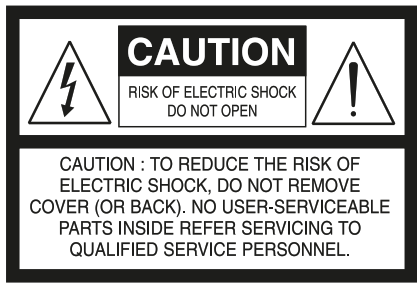
The equipment draws its nominal non-operational power from the AC outlet with its POWER switch in the ON position.The socket-outlet shall be installed near the apparatus and shall be easily accessible.CAUTIONChanges or modifications to this equipment not expressly approved by NAD Electronics for compliance could void the user’s authority to operate this equipment.CAUTION REGARDING PLACEMENTTo maintain proper ventilation, be sure to leave a space around the unit (from the largest outer dimensions including projections) that is equal to or greater than shown below. Left and Right Panels: 10 cm Rear Panel: 10 cm Top Panel: 10 cm
NOTES ON ENVIRONMENTAL PROTECTION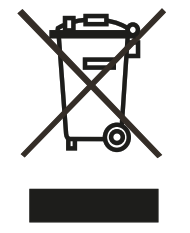 At the end of its useful life, this product must not be disposed of with regular household waste but must be returned to a collection point for the recycling of electrical and electronic equipment. The symbol on the product, user’s manual, and packaging point this out.
At the end of its useful life, this product must not be disposed of with regular household waste but must be returned to a collection point for the recycling of electrical and electronic equipment. The symbol on the product, user’s manual, and packaging point this out.
The materials can be reused in accordance with their markings. Through re-use, recycling of raw materials, or other forms of recycling of old products, you are making an important contribution to the protection of our environment. Your local administrative office can advise you of the responsible waste disposal point.
INFORMATION ABOUT COLLECTION AND DISPOSAL OF WASTE BATTERIES (DIRECTIVE 2006/66/EC OF THE EUROPEAN PARLIAMENT AND THE COUNCIL OF EUROPEAN UNION) (FOR EUROPEAN CUSTOMERS ONLY)
Batteries bearing any of these symbols indicate that they should be treated as a “separate collection” and not as municipal waste. It is encouraged that necessary measures are implemented to maximize the separate collection of waste batteries and to minimize the disposal of batteries as mixed municipal waste.
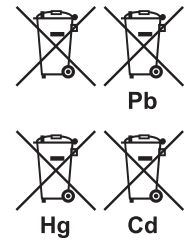 End-users are exhorted not to dispose of waste batteries as unsorted municipal waste. In order to achieve a high level of recycling waste batteries, discard waste batteries separately and properly through an accessible collection point in your vicinity. For more information about the collection and recycling of waste batteries, please contact your local municipality, your waste disposal service or the point of sale where you purchased the items.
End-users are exhorted not to dispose of waste batteries as unsorted municipal waste. In order to achieve a high level of recycling waste batteries, discard waste batteries separately and properly through an accessible collection point in your vicinity. For more information about the collection and recycling of waste batteries, please contact your local municipality, your waste disposal service or the point of sale where you purchased the items.
By ensuring compliance and conformance to proper disposal of waste batteries, potential hazardous effects on human health is prevented and the negative impact of batteries and waste batteries on the environment is minimized, thus contributing to the protection, preservation, and quality improvement of the environment.RECORD YOUR MODEL NUMBER (NOW, WHILE YOU CAN SEE IT)The model and serial number of your new C 268 are located on the back of the cabinet. For your future convenience, we suggest that you record these numbers here:
INTRODUCTION
GETTING STARTEDQUICK STARTRefer to the supplied C 268 Quick Setup Guide for basic instructions in setting up your new NAD C 268. The following guidelines must be observed when setting up your C 268.
- Before setting up or making connections, ensure that the C 268 and other devices to be connected to C 268 are unplugged or powered down.
- Connect your speakers to the LEFT and RIGHT speaker terminals. Connect the speaker cables to the corresponding speaker terminal connections (R +/-, L +/-) as reflected in the C 268 rear panel. Bare wire or lose strands from the speaker cables must not touch the rear panel or other speaker terminals.
- Connect the line output terminal of your external sources to the BALANCED and/or SINGLE-ENDED ANALOG AUDIO INPUT ports using applicable connectors.IMPORTANT NOTES• The blue terminals must never be connected to the ground (earth).• Never connect the blue terminals together or to any common ground device.• Do not connect the output of this amplifier to any headphone adapter, speaker switch or any device that uses common ground for left and right channels.
- Connect the corresponding end of the mains power cord to the AC mains input of C 268 and the plug connected to a mains power source.WARNINGFor optimal performance, the C 268 requires a grounded AC receptacle or a separate earth ground. Ensure the proper grounding of your system.
- Maintain default settings of the following control switches’• LEFT and RIGHT SELECT towards BALANCED or SINGLE-ENDED (both switches must be of the same setting)• INPUT SELECT to FIX• AUTO SENSE LEVEL to MID
- Set the POWER switch at the rear panel to “ON” setting. The Standby LED indicator will illuminate amber. Press front panel STANDBY button to turn ON the C 268. The Standby LED indicator will turn from amber to blue. Your C 268 is now powered up!
SAVE THE PACKAGINGPlease save the box and all of the packaging in which your C 268 arrived. Should you move or otherwise need to transport your C 268, this is by far the safest container in which to do so. We’ve seen too many otherwise perfect components damaged in transit for lack of a proper shipping carton, so please: Save that box!
NOTES ON INSTALLATION
- Place your NAD C 268 on a firm, level surface.
- Avoid placing the unit in direct sunlight or near sources of heat and damp.
- Do not place the unit on a soft surface like a carpet.
- Do not place the C 268 in an enclosed position such as a bookcase or cabinet that may impede the airflow through the ventilation slots. Allow adequate ventilation.
- Make sure the unit is switched off before making any connections.
- The RCA sockets on your C 268 are color-coded for convenience. Red and white are Right and Left audio respectively. Use high-quality leads and sockets for optimum performance and reliability.
- Ensure that leads and sockets are not damaged in any way and all sockets are firmly pushed home.
- Should water get into your C 268, shut off the power to the unit and remove the plug from the AC socket. Have the unit inspected by a qualified service technician before attempting to use it again?
- Use a dry soft cloth to clean the unit. If necessary, lightly dampen the cloth with soapy water. Do not use solutions containing benzol or other volatile agents.
DO NOT REMOVE THE COVER; THERE ARE NO USER-SERVICEABLE PARTS INSIDE.
IDENTIFICATION OF CONTROLS
FRONT PANEL

- STANDBY BUTTON• Press Standby button to switch ON the C 268 from standby mode. The Power indicator will change from amber to blue color.• Pressing Standby button again switches back C 268 to standby mode. The Power indicator will change from blue to amber color.• The Standby button cannot activate the C 268 if the rear panel POWER switch is off.
- POWER INDICATOR• This indicator will be amber when the C 268 is in standby mode.• When the C 268 is powered up from standby mode, this indicator will change in color from amber to red and finally blue.IMPORTANT NOTESFor the Standby button to activate, the following must occur:a .The supplied power cord from the C 268 must be plugged into a power source.b The rear panel POWER switch must be set to ON.
- BRIDGE MODE INDICATOR• This BRIDGE MODE indicator lights up blue when the Bridge Mode switch at the rear panel is set to ON (MONO).• Refer also to item 13 BRIDGE MODE on page

- BALANCED• Connect XLR audio source to these connectors. Ensure that proper pin configurations are followed – Pin 1: Ground, Pin 2: Positive (signal live) and Pin 3: Negative (signal return)
- SELECTUse SELECT switch to choose which audio input will be the active source.• Select SINGLE-ENDED audio input by setting SELECT switch to the right towards the direction of SINGLE ENDED input.• Select BALANCED audio input by setting SELECT switch to the left towards the direction of BALANCED input.
- SINGLE-ENDED• Use a twin RCA-to-RCA lead to connect these sockets to the left and right analog output of a preamplifier, processor or any compatible device.
- GROUND• Ensure that the C 268 is plugged in to a grounded AC wall outlet..If a separate earth ground is necessary, use this terminal to ground your C 268. The C 268 can be connected to the ground by connecting a ground lead wire or similar to this terminal. After insertion, tighten the terminal to secure the lead.
- LINE OUT• The LINE OUT sockets allow “daisy-chaining” – use more than one amplifier to add speakers to the same channel.• Use dual RCA cable to connect LINE OUT to the corresponding analog audio input of compatible devices such as amplifiers, receivers or other applicable devices.
- INPUT SELECTUse INPUT SELECT switch to manage audio output level.• FIX: Audio output level is fixed. The C 268 becomes like a basic amplifier with an audio output level controlled by an external device.• VAR: Audio output level can be adjusted using the INPUT LEVEL control knob.
- INPUT LEVELWith INPUT SELECT switch set to VAR, the INPUT LEVEL control knob can be used to adjust the audio output level of the C268.• Turn clockwise to increase audio output level; counterclockwise to lower it.NOTEThe INPUT LEVEL is a level trim only and not a full volume control.
- AUTO SENSE LEVELAuto Sense features instantaneously turns the C 268 to operating mode from standby mode if it senses a specific input signal level applied to either the BALANCED or SINGLE-ENDED sockets. There are three Auto Sense levels
SETTING INPUT LEVEL Low 0.85 mV Mid 1.7 mV High 3.7 mV - +12V TRIGGER IN/OUT+12V TRIGGER OUT• The +12V TRIGGER OUT is used for controlling external equipment equipped with a +12V trigger input.• Connect this +12V TRIGGER OUT to the other equipment’s corresponding +12V DC input jack using a mono cable with 3.5mm male plug.• This output will be 12V when the C 268 is ON and 0V when it is either OFF or in standby mode.+12V TRIGGER IN• With this input triggered by a 12V DC supply, the C 268 can be switched ON remotely from standby mode by compatible devices such as amplifiers, preamplifiers, receivers, etc. If the 12V DC supply is cut off, the C 268 will return to standby mode.• Connect this +12V Trigger input to the remote device’s corresponding +12V DC output jack using a mono cable with 3.5mm male plug. The controlling device must be equipped with a +12V trigger output to use this feature.
- BRIDGE MODEThe C 268 amplifier can be configured to be MONO (Bridge Mode), more than doubling its output power. This way, the C 268 can be used as part of a high power stereo or home-theatre system, by connecting additional power amplifiers.• In BRIDGED MODE (switch at ON (MONO) setting), the C 268 will produce approximately 300W into an 8-ohm loudspeaker. In this mode, the amplifier sections will react as though the speaker impedance has been halved. Low impedance speakers (under 8 ohms) are not recommended when using Bridge Mode as these may cause the amplifier’s thermal cut-out to operating if played at high levels.• Set BRIDGE MODE switch to the “ON (MONO)” position and connect the speaker to the terminals marked “L +” and “R-” ensuring that the “L+” is connected to the “+” terminal of your speaker and the “R-” is connected to the speaker’s “ – ” terminal.• Set BRIDGE MODE switch to OFF (Stereo) for normal operation.IMPORTANT NOTEIf C 368 is the signal source, connect only C 368 Right channel PRE OUT to C 268 LEFT input (both C 368 and C 268 in BRIDGE mode). Never use C 368 Left channel PRE OUT to drive C 268 LEFT input.
- SPEAKERS• Connect C 268’s Right speaker terminals marked “R +” and “R-” to the corresponding “+” and “-“ terminals of your designated right speaker. Repeat the same for C 268’s Left speaker terminals and corresponding left speaker.• Double-check the speaker connections before powering up the C 268.IMPORTANT NOTES• The blue terminals must never be connected to the ground (earth).• Never connect the blue terminals together or to any common ground device.• Do not connect the output of this amplifier to any headphone adapter speaker switch or any device that uses a common ground for left and right channels.NOTES• Use 16 gauge (American Wire Gauge or AWG) or lower stranded wire. Connections to the C 268 can be made with banana-type plugs.• Bare wire or pins can also be used by loosening the terminal’s plastic nut, making a clean, neat connection and re-tightening. To minimize the danger of a short circuit, ensure that only 1/2-inch of exposed wire or pin is used to connect and no loose strands of speaker wire.
- POWER• Supplies the AC mains power to the C 268.• When the POWER switch is set to ON position, the C 268 goes to standby mode as shown by the amber status condition of the front panel Power indicator.• Press the front panel Standby button to switch ON the C 268 from standby mode.• If you do not intend to use the C 268 for long periods of time (such as when on vacation), switch off the POWER switch.• With POWER switched off, the front panel Standby button cannot activate the C 268.
- FUSE HOLDER• Only qualified NAD service technicians can have access to this fuse holder. Opening this fuse holder may cause damage thus voiding the warranty of your C 268.
- AC MAINS INPUT• The C 268 comes supplied with two separate mains power cords. Select the mains power cord appropriate for your region.• Before connecting the plug to the mains power source, ensure that it is firmly connected to the C 268’s AC Mains input socket.• Always disconnect the mains power plug from the mains power source before disconnecting the cable from the C 268’s AC Mains input socket.
REFERENCE
SPECIFICATIONS
| ANALOG AUDIO INPUT/LINE OUT | |
| THD (20 Hz – 20 kHz) | <0.003 % at 2V out |
| Signal-to-Noise Ratio | >110 dB (IHF; 20 Hz – 20 kHz, ref. 2V out) |
| Channel separation | >90 dB (1 kHz) |
| >75 dB (10 kHz) | |
| Input impedance (R and C) | Single-ended: 33 kohms + 220 pF |
| Balanced: 10 kohms +20 pF | |
| Maximum input signal | >7.0 Vrms (ref. 0.1 % THD) |
| Output impedance | 440 ohms |
| Frequency response | ±0.1 dB (20 Hz – 20 kHz) |
| Maximum voltage output -IHF load | >7.0 V (ref. 0.1 % THD) |
ANALOG AUDIO INPUT/SPEAKER OUT
| Continuous output power into 8 ohms and 4 ohms (Stereo mode) | 80 W (ref. 20 Hz-20 kHz at rated THD, both channels driven) |
| Continuous output power into 8 ohms (Bridge mode) | 300 W (ref. 20 Hz – 20 kHz at THD 0.03%) |
| THD (20 Hz – 20 kHz) | <0.03 % (250 mW to 80 W, 8 ohms and 4 ohms) |
| Signal-to-Noise Ratio | >98 dB (A-weighted, 500 mV input, ref. 1 W out in 8 ohms) |
| Clipping power (Stereo mode, at 1 kHz 0.1 % THD) | >95 W |
| Clipping power (Bridge mode, at 1 kHz 0.1 % THD) | >315 W |
| IHF dynamic power (Stereo mode, at 1 kHz 1 % THD) | 8 ohms: 120 W |
| 4 ohms: 200 W | |
| 2 ohms: 250 W | |
| IHF dynamic power (Bridge mode, at 1 kHz 1 % THD) | 8 ohms: 500 W |
| 4 ohms: 560 W | |
| Peak output current | >20 A (in 1 ohm, 1 ms) |
| Damping factor | >100 (ref. 8 ohms 20 Hz – 20 kHz) |
| Frequency response | ±0.3 dB (20 Hz – 20 kHz) |
| Channel separation | >80 dB (1 kHz) |
| >70 dB (10 kHz) | |
| Input sensitivity (for 80 W in 8 ohms) | Fixed Gain mode: 920 mV |
| Bridge Mode Gain
Line In – Balanced and Single-ended |
Fixed Gain mode: 25 dB |
| Variable Gain mode: 14.5 dB – 34.5 dB | |
| Bridge Mode Sensitivity | Fixed Gain mode: 2.8 V for 300 W in 8 ohms |
| Line In – Balanced and Single-ended | Variable Gain mode at maximum: 940 mV for 300 W in 8 ohms |
| Bridge Mode Gain, C 268 and C 368 (RHC Pre Out C 368 driving LHC Line Input C 268) | Fixed Gain mode: 43 dB at maximum volume C 368 |
| Bridge Mode Sensitivity (same configuration as above) | 350 mV for 300 W |
| Standby power | <0.5 W |
| DIMENSION AND WEIGHT | |
| Gross dimensions (W x H x D) | 435 x 100 x 390 mm |
| 17 1/8 x 3 15/16 x 15 3/8 inches | |
| Net weight | 7.3 kg (16.1 lbs) |
| Shipping weight | 8.7 kg (19.2 lbs) |
* – Gross dimension includes feet and extended rear panel terminals.Specifications are subject to change without notice. For updated documentation and features, please check out www.NADelectronics.com for the latest information about C 268.

www.NADelectronics.com©2017 NAD ELECTRONICS INTERNATIONALA DIVISION OF LENBROOK INDUSTRIES LIMITED
All rights reserved. NAD and the NAD logo are trademarks of NAD Electronics International, a division of Lenbrook Industries Limited. No part of this publication may be reproduced, stored, or transmitted in any form without the written permission of NAD Electronics International. While every effort has been made to ensure the contents are accurate at the time of publication, features and specifications may be subject to change without prior notice.
C268_ENG_OM_V09 – NOV 2017
References
[xyz-ips snippet=”download-snippet”]


